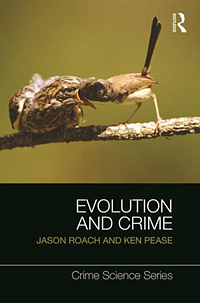Evolution and Crime
Thu, 25 Apr 2013 16:09:00 BST
An alternative way of understanding criminal behaviour
 EVOLUTIONARY insights can contribute to a greater understanding of criminal behaviour. And this is a factor which should play a much greater role in criminological analysis, argues a University of Huddersfield researcher and co-author of a newly-published book on the subject.
EVOLUTIONARY insights can contribute to a greater understanding of criminal behaviour. And this is a factor which should play a much greater role in criminological analysis, argues a University of Huddersfield researcher and co-author of a newly-published book on the subject.
But UK criminologists in particular – fearful of being linked with discredited theories such as eugenics and the perceived dangers of biological determinism – are reluctant to allow evolution into the equation, remaining more wedded to sociological explanations for crime, says Dr Jason Roach. Writing in tandem with Professor Ken Pease, who is one of the world’s most-respected criminologists, he aims to encourage students to consider redressing the balance.
Child homicide is one example of a crime which can often be comprehended more easily if evolution is introduced into the analysis, according to Dr Roach.
“Quite often, when children are killed it is by their non-biological parent, such as a mother’s new boyfriend. Mainstream criminology struggles to explain why this is the case across all social strata. We can’t dismiss all these step-parental figures as being psychologically disturbed and we can’t explain it from other angles, like poverty,” he said.
 Instead, argues Dr Roach, such crimes might be better explained because an evolutionary instinct means that some men feel little need to invest any parental responsibility in children who are not biologically theirs – as in the tragic case of baby Peter Connolly.
Instead, argues Dr Roach, such crimes might be better explained because an evolutionary instinct means that some men feel little need to invest any parental responsibility in children who are not biologically theirs – as in the tragic case of baby Peter Connolly.
An understanding of the evolutionary process – who we are as a species and where we have evolved from – can also explain how and why legal systems have developed, as a means of regulating competition between individuals. Dr Roach has also explored empathy and altruism – unique to human beings – and how they function as protective factors to mitigate anti-social behaviour.
“A function of empathy is that it makes us a safer, society stronger. From an evolutionary perspective, if you are have a high level of empathy, you are not going to want to hurt another human or be engaged in anti-social behaviour. Empathy is a mechanism which has evolved to help us co-operate and to become the highly social beings we are. The more social we are, the less violent we tend to be.
“The default position is one of empathy, so those that do engage in anti-social behaviour should perhaps be nudged towards being more empathic, rather than just simply punished,” argues Dr Roach, who is Reader in Crime and Policing at the University of Huddersfield.
There is no ‘criminal gene’
 His new book, co-authored with Professor Pease, is entitled Evolution and Crime. It argues that although the received scientific wisdom is that human physique and behaviour have been shaped by the pressures of natural selection, the topic of crime is rarely touched on in textbooks on evolution and the topic of evolution is ever rarer in criminology textbooks.
His new book, co-authored with Professor Pease, is entitled Evolution and Crime. It argues that although the received scientific wisdom is that human physique and behaviour have been shaped by the pressures of natural selection, the topic of crime is rarely touched on in textbooks on evolution and the topic of evolution is ever rarer in criminology textbooks.
Although criminologists overseas are more prepared to consider the role of evolution, in Britain until recently at least, criminologists have been more wary of any explanations for behaviour which involve biology and genes, says Dr Roach.
“Therefore criminal behaviour is seen to be about society affecting people’s behaviour – we are essentially born as blank slates and criminals are made rather than born. I agree with this to an extent – I don’t at all think that there is a criminal gene – but we are the product of evolution and we are what we are as a result of environments that our ancestors have inherited and inhabited.
“All human behaviour is the result of the interaction between our biology and our environment. All we are saying is that it has proved fruitful in other areas of science and might be fruitful in the social sciences to look at where our biology has come from and how it has evolved in order to better understand the biology part of the equation. Not to totally replace the equation with genes.
“So some people have a slight predisposition for certain behaviours and in certain environments they are more inclined to be anti-social. For example, most of us would find a scenario where a man kills another man because he found him in bed with his wife more understandable than one where he kills another man because he looked at him in a funny way. Although the end result is the same, our understanding and likely court verdict will differ greatly. An evolutionary focused explanation would look at the why.”
“There is possibly a fear among some criminologists that evolutionary explanations for crime could be seen as biological determinism, where human action is more the result of biology than rational thought or ‘freewill’, which is clearly wrong. Genes can influence our behaviour, but are in turn influenced by the environment. We are not all driven by our genes, there is no ‘criminal gene’ and to cite genetic predisposition as a defence in court would be quite ridiculous,” suggests Dr Roach.
Alternative way of understanding criminal behaviour
 There could be practical applications to his work on evolution and crime, he added. For example, most crime was committed by males aged 16-24, more likely to take risks because they feel they have nothing to lose.
There could be practical applications to his work on evolution and crime, he added. For example, most crime was committed by males aged 16-24, more likely to take risks because they feel they have nothing to lose.
“If you look at our society it is older men that wield all the power. Rich older men also attract young females, which you might say gives them a distinct advantage over their younger counterparts,” said Dr Roach.
“Most young men who commit crime eventually desist by their late twenties, mainly because they ‘grow up’. So we need to speed that process up and give them a sense of hope that their time will come and stop them taking all these risks.”
Dr Roach said that he and Professor Pease were not arguing that conventional criminology is misguided.
“We are not trying to make the case that biology or evolution is everything and that traditional sociological explanations are wrong at all. We don’t pour scorn on any other criminological explanations, but we think they sit on top of an evolutionary explanation. The aim of the book is simply to introduce criminology students to an alternative way of understanding and explaining criminal behaviour, not to encourage them to tear up their existing course text. If in the future, a chapter on the evolutionary approach appears alongside other explanations for crime and criminality then we will be happy and the four years we took to write Evolution and Crime will have been more than worth it.”
- Evolution and Crime, by Jason Roach and Ken Pease, is published by Willan. ISBN-10: 1843923920. ISBN-13: 978-1843923923. Click here to view







